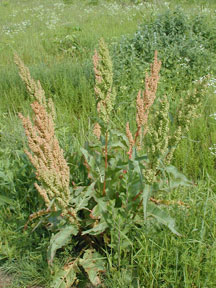CURLY DOCK
|
 |
| File Size: 140 KB |
|
|
|
Rumex crispus L.
|
| Riley County, Kansas |
| Perennial |
| Height: 8-60 inches |
| Family: Polygonaceae - Buckwheat Family |
| Flowering Period: April, May, June |
|
| Also Called: | | Curly-leaf dock, sour dock, yellow dock. | | Stems: | | Erect, single or in groups, stout, unbranched below inflorescence, glabrous, often reddish. | | Leaves: | | Alternate, simple, mostly basal, dark green, oblong-lanceolate to linear-lanceolate, 6 to 12 inches long, 1 to 4 inches wide, prominent midvein; margins wavy curled (crisped); tip pointed; base rounded or nearly heart-shaped; conspicuous stipular membrane sheaths stem at bases of leaves; basal leaf stalks 1 to 5 inches long; stem leaves reduced in size. | | Inflorescences: | | Panicle of whorled racemes, large, to 14+ inches long, densely flowered, terminal; branches many, erect or closely ascending; greenish or pinkish at flowering; reddish-brown in fruit. | | Flowers: | | Perianth segments 6, in 2 whorls of 3, united basally, more or less alike at flowering, greenish or pinkish, becoming reddish-brown with age; outer whorl small, not turned downward in fruit; inner whorl enlarging, segments called "valves"; valves heart-shaped to triangular, 1/6 to 1/5 inch long and wide; margins mostly entire; each with small tubercle (wart-like swelling) 1/2 or less than 1/2 length of valve; stamens 6. | | Fruits: | | Achene, 3-angled, reddish-brown, enveloped by valves; seed 1, small. | | Habitat: | | Open, moist disturbed areas, roadsides, abandoned feedlots and farmsteads, waste ground, fields, stream and pond borders. | | Distribution: | | Throughout Kansas. | | Origin: | | Native to Eurasia; now naturalized. | | Toxicity: | | Toxic to sheep due to oxalate concentrations but not generally a problem unless large quantities have been consumed. Clinical signs include: depression, tremors, difficulty walking, excessive salivation, and labored breathing. | | Uses: | | Native Americans used curly dock for a number of medicinal purposes. A poultice of mashed roots was applied to cuts, sores, and used to alleviate itching and rheumatism. A tea of the roots was used to treat upset stomachs and abdominal cramps. The leaves were rubbed in the mouth for sore throats. The leaves were sometimes boiled and eaten as greens and the seeds were a food source. Songbirds and waterfowl eat the seeds. | | Comments: | | Curly dock is a weedy species whose pollen can cause allergy symptoms. Some people encounter skin inflammation when handling this plant. | | | | See
pale dock or
wild begonia. |
|
| Curly dock inflorescence |  | | 91 KB | | Tallgrass Prairie National Preserve, Chase County, Kansas |
| | Curly dock leaves |  | | 166 KB | | Tallgrass Prairie National Preserve, Chase County, Kansas |
| | Curly dock flowers |  | | 67 KB | | Tallgrass Prairie National Preserve, Chase County, Kansas |
| | Curly dock in fruit |  | | 163 KB | | Tallgrass Prairie National Preserve, Chase County, Kansas |
| | Curly dock inflorescence in fruit |  | | 141 KB | | Tallgrass Prairie National Preserve, Chase County, Kansas |
| | Curly dock valves |  | | 67 KB | | Tallgrass Prairie National Preserve, Chase County, Kansas |
| | Curly dock |  | | 157 KB | | Tallgrass Prairie National Preserve, Chase County, Kansas |
| | | |
|
|
|
|
|
|